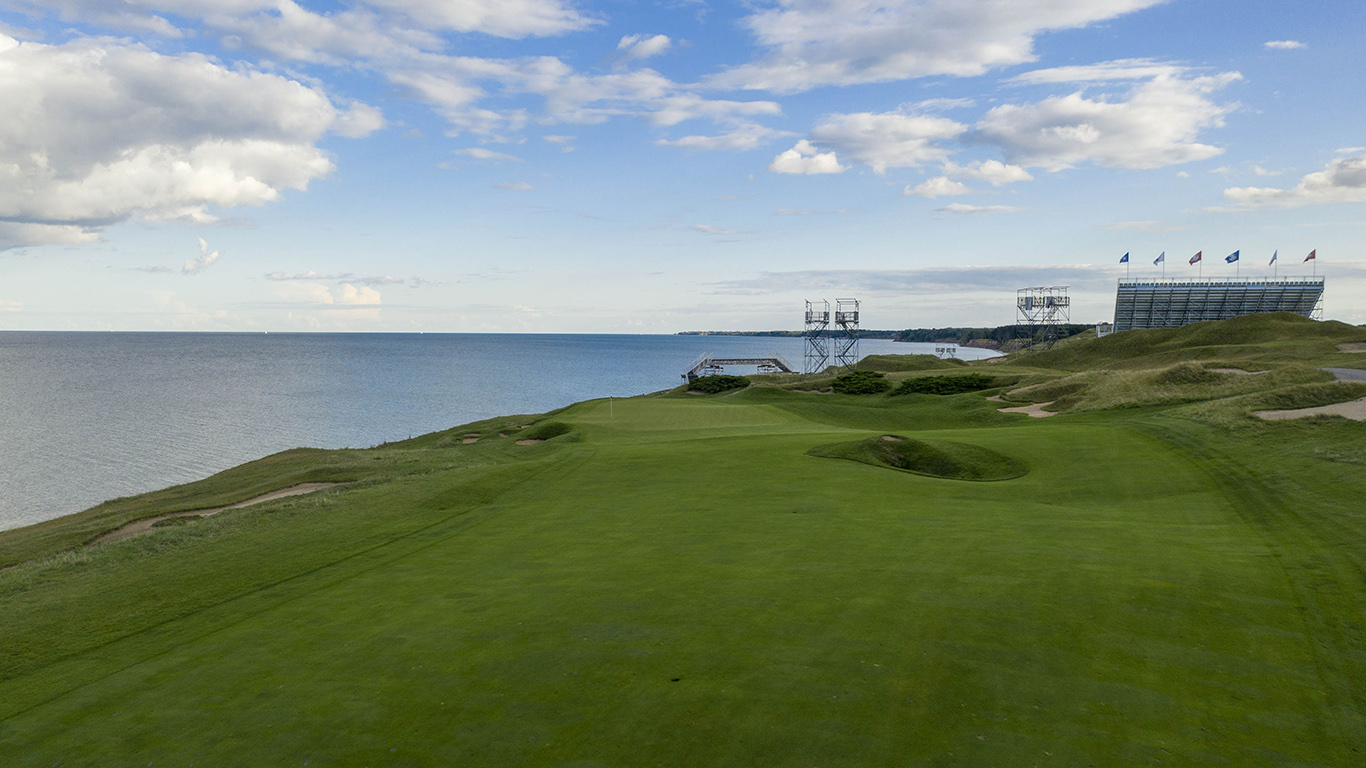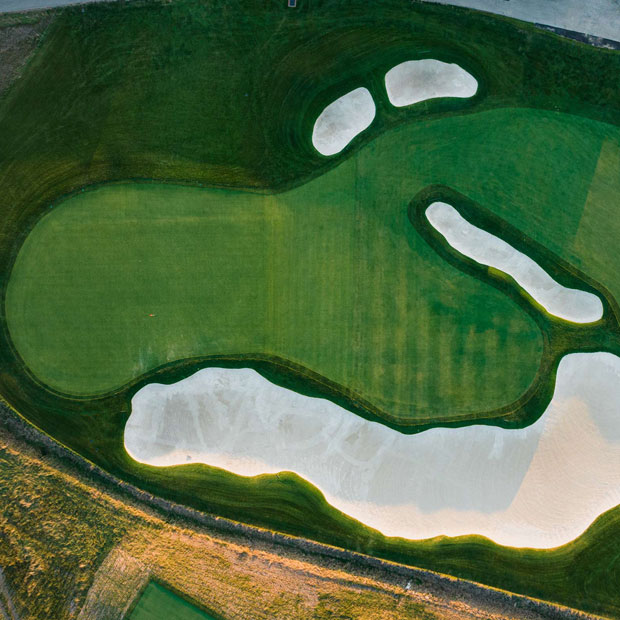One Thing About Every Hole at Whistling Straits
A quick tour of the 2020 Ryder Cup venue


We know. It’s Wednesday, and you have Ryder Cup content fatigue. You’ve already heard too much about host venue Whistling Straits, and all the takes are getting jumbled up in your head. So let’s cut through the clutter. (Or maybe add to it? Sorry.) Here is one thing to remember about each hole at the Pete Dye-designed Straits Course:
Hole 1 – par 4 – 364 yards
The opener is one of four holes at Whistling Straits (the others being 9, 10, and 18) that connect the clubhouse with the lakefront. This short par 4 has been made shorter by infrastructure, so Bryson DeChambeau and other power players may be able to drive it. If that happens in front of thousands of fans, I won’t hate watching it.
First tee shot is unlike anything else in the world of golf. Gotta see it.
Then go find a spot *with a Jumbotron* either on the back half of the front nine or a really key hole on the back.
Drink, watch it on TV, cheer with the other people that have gone up ahead, and wait. https://t.co/fZ0Pl6faPE
— No Laying Up (@NoLayingUp) September 20, 2021

The 1st hole at Whistling Straits. Photo: Andy Johnson
Hole 2 – par 5 – 593 yards
The crazy-deep bunker to the right of the fairway on this par 5 looks scarier, but one of the coolest bunkers at the Straits Course sits on the approach to the green. Resembling a principal’s nose in its construction, it makes for awkward lies that barely allow the player to move the ball forward.

The 2nd hole at Whistling Straits. Photo: Andy Johnson
Hole 3 – par 3 – 181 yards
The 3rd has beautiful, wavy ridges that emulate the ripples of Lake Michigan. What I like about these contours is that they move diagonally to the line of play rather than perpendicularly. As a result, a slight pull may fail to climb one of the ridges, while a push can make it over.

The 3rd hole at Whistling Straits. Photo: Andy Johnson
Hole 4 – par 4 – 489 yards
Since the 4th hole gets narrow in the pros’ usual landing zone, longer hitters would have an edge if the tee were up, giving them a chance to fly it over the trouble and into the generous section of fairway beyond.

The 4th hole at Whistling Straits. Photo: Andy Johnson
Hole 5 – par 5 – 603 yards
Tee selection and wind are the key variables here. If it’s downwind, the big boys may be able to cut the dogleg and turn this long par 5 into a shortish par 4. It’s possible that Pete Dye meant for the sharp “S” shape of this fairway to curb the advantage of distance, but for today’s top pros, it does the opposite.
One hole where Bryson could take a mega-shortcut? No. 5, which is listed at 571 yds but can play much shorter (depending on wind, tee box and ball speed).
During a practice round he cut the corner and had 120 in, while other guys played up the left and had 3-wood or hybrid in. pic.twitter.com/Pqq6ye8mMm
— Dylan Dethier (@dylan_dethier) September 21, 2021

The 5th hole at Whistling Straits. Photo: Andy Johnson
Hole 6 – par 4 – 355 yards
The brilliance of this short par 4 comes from its unique green, which is shaped like a pair of glasses. The left eye is accessible, even drivable because of the slopes feeding into it. The right eye is a different story. It’s small and surrounded by trouble, and it can be attacked only through the air. When the pin is on the right, watch for players’ decisions off the tee. A layup leaves a tough wedge, but going for it could result in a disastrous encounter with the deep center bunker.

The 6th hole at Whistling Straits. Photo: Andy Johnson
Hole 7 – par 3 – 221 yards
Benched into the lakefront, the 7th is a completely manufactured hole. Pete Dye’s team dug out the lakeside bluffs in order to elevate the inland sections of the course. That massive feat of earthmoving left this intimidating par 3 hard against the water.

The 7th hole at Whistling Straits. Photo: Andy Johnson
Hole 8 – par 4 – 507 yards
On this brawny par 4, Ryder Cuppers will need their longest, most accurate tee shot. If they miss the corridor (which includes the fairway as well as the short rough), the penalty will be severe.

The 8th hole at Whistling Straits. Photo: Andy Johnson
Hole 9 – par 4 – 446 yards
This is one of the smallest greens, if not the smallest, on the course. Scrambling will often be critical here.

The 9th hole at Whistling Straits. Photo: Andy Johnson
Hole 10 – par 4 – 341 yards
The second potentially drivable hole at Whistling Straits, the 10th incentivizes players to go for the green because a layup leaves an uneven lie and a blind approach. Pushing farther up yields a flatter lie and better visibility.

The 10th hole at Whistling Straits. Photo: Andy Johnson
Hole 11 – par 4 – 519 yards
Typically a par 5, the 11th will play as a big par 4 at the Ryder Cup. According to Joseph LaManga, hitting the fairway here is unusually important. Since there’s a brutal bunker 20 yards short of the green, a running approach from the rough isn’t a good option.

The 11th hole at Whistling Straits. Photo: Andy Johnson
Hole 12 – par 3 – 143 yards
The wildest green on the Straits Course snakes from front left to back right and contains a number of tiers, bumps, and rolls. The orientation of the green makes things tough on right-handers (all 24 competitors), whose common misses are short right and long left.

The 12th hole at Whistling Straits. Photo: Andy Johnson
Hole 13 – par 4 – 404 yards
My favorite aspect of this stunning hole will likely be irrelevant for Ryder Cup players: the feeder slopes around the green allow for a variety of fun run-up shots.

The 13th hole at Whistling Straits. Photo: Andy Johnson
Hole 14 – par 4 – 396 yards
Since it’s not on the lake, the 14th is somewhat slept-on, but it fits more gracefully into its artificial landscape than any other hole at Whistling Straits. The green site appears natural even though it was created from nothing.

The 14th hole at Whistling Straits. Photo: Andy Johnson
Hole 15 – par 4 – 518 yards
Like the 3rd green, the 15th green has flowing contours that mimic the surface of Lake Michigan. In this case, the lake looms behind the hole—a beautiful sight.

The 15th hole at Whistling Straits. Photo: Andy Johnson
Hole 16 – par 5 – 569 yards
The final par 5 on the course is the last real birdie opportunity. Like all of the long holes at Whistling Straits, the 16th puts a premium on finding either the fairway or the short rough. If you’re errant off this tee, you’ll have a hard time getting home in two.

The 16th hole at Whistling Straits. Photo: Andy Johnson
Hole 17 – par 3 – 223 yards
Arguably the toughest single shot on the course, the 17th hole will reveal a player’s confidence, or lack thereof. Most will probably aim for the right half of the green, giving a wide berth to the treacherous left side.

The 17th hole at Whistling Straits. Photo: Andy Johnson
Hole 18 – par 4 – 515 yards
The cross-hazard creek here is devastating for average golfers, many of whom have to lay back to 150+ yards on their second shots. But the creek also gives pros fits: if they miss the fairway, they have a tough decision to make; if they decide to go for it, great theater.

The 18th hole at Whistling Straits. Photo: Andy Johnson
Want more Whistling Straits? Check out our YouTube video:
Leave a comment or start a discussion
Engage in our content with thousands of other Fried Egg Golf Members
Engage in our content with thousands of other Fried Egg Golf Members
Get full access to exclusive benefits from Fried Egg Golf
- Member-only content
- Community discussions forums
- Member-only experiences and early access to events





.webp)





Leave a comment or start a discussion
Lorem ipsum dolor sit amet, consectetur adipiscing elit. Suspendisse varius enim in eros elementum tristique. Duis cursus, mi quis viverra ornare, eros dolor interdum nulla, ut commodo diam libero vitae erat. Aenean faucibus nibh et justo cursus id rutrum lorem imperdiet. Nunc ut sem vitae risus tristique posuere. uis cursus, mi quis viverra ornare, eros dolor interdum nulla, ut commodo diam libero vitae erat. Aenean faucibus nibh et justo cursus id rutrum lorem imperdiet. Nunc ut sem vitae risus tristique posuere.